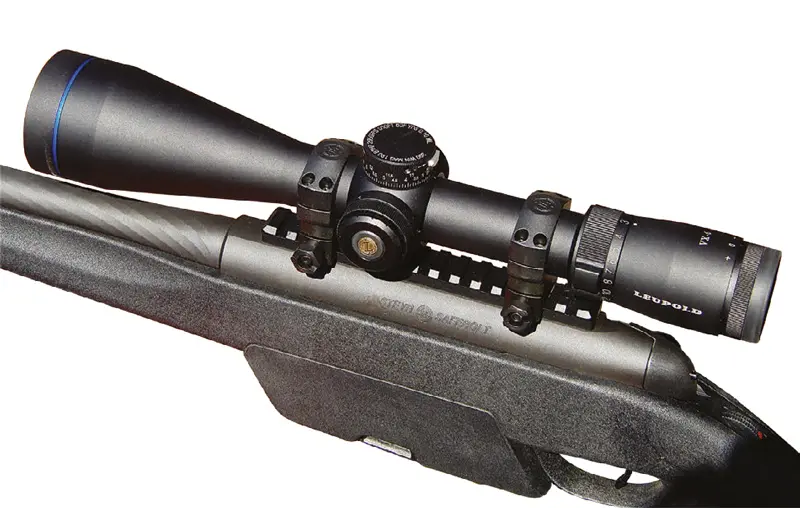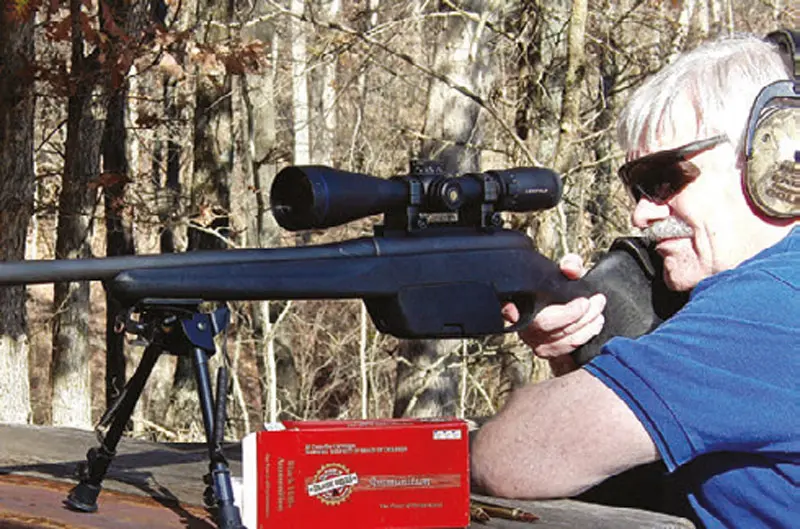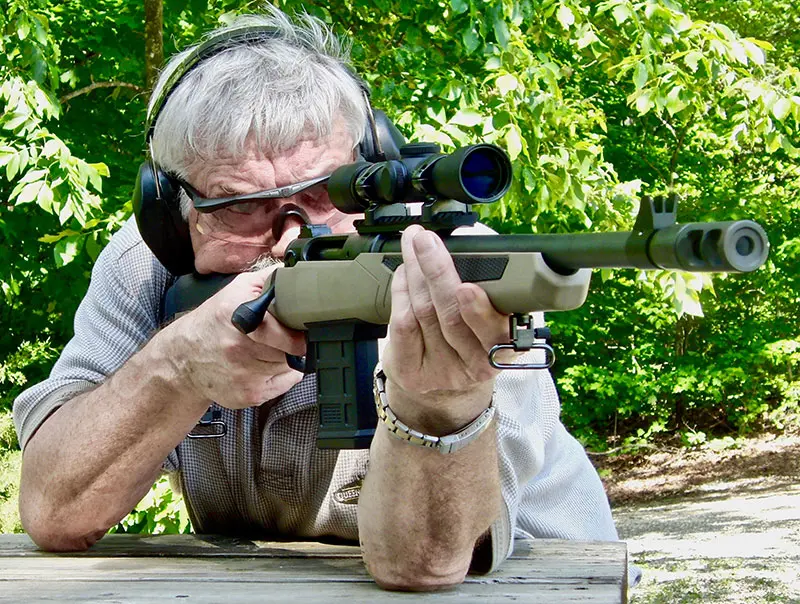I have used Leupold’s Custom Shop for some years, mostly for custom dials that tailor my scope to a specific caliber and load. But a few weeks ago, the Custom Shop built me one of their new Blue Line scopes, which are designed specifically for the law enforcement market.
The designation “Blue Line” was given to the scope on the assumption that it will appeal to law enforcement officers. In fact, the Leupold Custom Shop will engrave an agency logo on the scope if so ordered.


The Blue Line allows the purchaser to customize one of the scopes in the Leupold Tactical line to fit his specific needs. Leupold also builds custom hunting and target scopes. In my case, the scope is based on the VX-6, 3-18X50.
I knew right away that I wanted the scope tailored to my Steyr SSG04 in .300 Win Mag. This is the only .300 Win Mag sniping rifle I own, so it gets used for ammo tests, as well as articles evaluating different sniper rifles. I can generally shoot ½ MOA groups with it, assuming good ammo and scope. I figured a Blue Line designed to maximize the SSG 04 was just what I wanted.
Among the features I chose are an illuminated TMR (Tactical Milling Reticle), mil adjustments, and two-revolution zero-lock dial. Although I had used mildot reticles for years, I’ve now been using the TMR reticle on the latest Leupold scopes I’ve tried.
Without going into great detail, anyone who has used the mil-dot reticle can adjust to the TMR quickly. Just as the mil-dot may be used for ranging, so can the hash marks/stadia lines on the TMR. For me, the hash marks allow more precision than the mil-dot. Adjustments for elevation and windage are also in mils.
Even though I lived and worked in Europe for a couple of years, I still think in inches and convert mils to decide on clicks when I measure point of impact in inches: 0.1 Mils at 100 yards equals .36 inch. As a result, three clicks equals 1.08 inches at 100 yards. Lines on the reticle vary in distance between them, thus allowing them to be used for ranging.
For example, thick black lines that lead the eye to the center of the reticle are 5 Mils in length, which equals 18 inches at 100 yards. Hash marks separated by 0.5 Mils translate to about 1.8 inches at 100 yards.
Normally, tactical marksmen learn the heights/widths of various items likely to be encountered (e.g., mail boxes, fire hydrants, car license plates). Distances may then be approximated. Or average heights of men or women may be used. For example, men are typically about 5 feet, 9 inches tall, so the 5 Mil bar should cover about half of the man’s height at about 200 yards.

A useful manual on using Mils is available from Leupold to aid in learning the system. Since my Blue Line was built with Mil adjustments, they are consistent with the reticle.
My scope has an illuminated reticle, which shows the center portion of the reticle in red. The left side of the parallax adjustment dial contains the button for illumination. Pressing and releasing the button turns on the illumination. Pressing the button repeatedly can increase the brightness to suit conditions.
Illumination can be turned off using the button, or if the scope does not move for a short time, the illumination turns off—a good system for keeping the battery from running down.
The two-revolution zero-lock dial is a useful feature, though more so on one of my .338 Lapua rifles than on a .300 Win Mag. Let me explain.
The two-revolution dial allows the dial to be turned through 720 degrees (or close to that). The zero-lock is designed to allow the shooter to return to the correct point of zero on the dial even when it has been passed by turning the dial more than 360 degrees.
Since one full rotation of the dial takes me to 1,000 yards, that should reach my outer range for the .300 Win Mag. To be honest, I would normally consider about 800 yards the max for me.
I also wanted to match the elevation dial to the load I use. I have found Black Hills 190-grain Match HPBT .300 Win Mag exceptionally accurate, so I ordered my Blue Line scope with an elevation dial matched to this load.

This CDS (Custom Dial System) dial also allows me to zero the rifle at the proper distance—in the case of the .300 Win Mag, 200 yards. Then, once zeroed, I can quickly adjust for elevation at a different range by just turning the dial to the mark for that distance (e.g., 4.5 equals 450 yards).
It is an excellent system that saves having to calculate and count clicks. I feel it is a real boon on a sniper rifle.
Blue Line scopes also feature all the other elements that make Leupold scopes so good. Anyone interested can read the details online, but I will mention the Diamond/Coat 2 lens treatment that aids light transmission and abrasion resistance. Leupold scopes have held up well against abrasion in Afghanistan and Iraq, a testament to Diamond/Coat 2.
Leupold’s Argon/Krypton waterproofing allows the scope to be used in very damp, humid conditions. I have done quite a bit of shooting in the rain using Leupold scopes and have never had any moisture get inside them.
One feature I appreciated immediately when zeroing and using the Blue Line is the 6:1 zoom ratio, which keeps images clear from the lowest to highest setting. On some variable-power scopes, there is degradation of the image in the middle range. Since I expect to use the Blue Line most often in the 6X to 12X range, this is appreciated.
Some of the scope’s specs are worth noting as well. Linear field of view at 100 yards on 3X is 38 feet and on 18X is 7 feet. Weight is 20.7 ounces, which isn’t bad for a scope with this much power. Overall length is 13.5 inches.
Specs and features aside, the best thing about the Blue Line is that it is easy and effective to use. I had the elevation dial regulated for a 200-yard zero. I didn’t bore sight the Blue Line, but instead fired a few rounds at 25 yards to get close, then moved to shooting at 200 yards to zero the scope.
Using the Black Hills 190-grain loads for which the dial is set, groups were very good, with ½ MOA being the norm. One or two groups were barely over that, and the best group was 0.75 inch for three shots at 200 yards. Once zeroed, I moved the elevation dial to “3” and fired a couple of groups at 300 yards, one just under 1.5 inches and one just over.
I was low on .300 Win Mag ammunition so did not move to longer range. As soon as I get in some more Black Hills ammo, I’ll shoot out to 500 yards or farther.
When I test a Leupold scope, I expect it to perform well, and I was not disappointed. Everything on the Blue Line worked the way it should, and the scope paired with the SSG 04 and Black Hills ammo made me look good.
I have described the scope as I ordered it. The Leupold Custom Shop can work with the customer to design a Blue Line that fits his needs.





